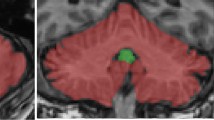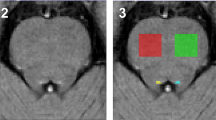Abstract
Objective
To determine whether brain volumetric and white matter microstructural changes are present and correlate with neurological impairment in subjects with alternating hemiplegia of childhood (AHC).
Methods
In this prospective single-center study, 12 AHC subjects (mean age 22.9 years) and 24 controls were studied with 3DT1-weighted MR imaging and high angular resolution diffusion imaging at 3T. Data obtained with voxel-based morphometry and tract-based spatial statistics were correlated with motor impairment using the International Cooperative Ataxia Rating Scale (ICARS) and Movement and Disability sub-scales of Burke-Fahn-Marsden Dystonia Rating Scale (BFMMS and BFMDS).
Results
Compared to healthy controls, AHC subjects showed lower total brain volume (P < 0.001) and white matter volume (P = 0.002), with reduced clusters of white matter in frontal and parietal regions (P < 0.001). No significant regional differences were found in cortical or subcortical grey matter volumes. Lower cerebellar subvolumes correlated with worse ataxic symptoms and global motor impairment in AHC group (P < 0.001). Increased mean and radial diffusivity values were found in the corpus callosum, corticospinal tracts, superior and inferior longitudinal fasciculi, subcortical frontotemporal white matter, internal and external capsules, and optic radiations (P < 0.001). These diffusion scalar changes correlated with higher ICARS and BFMDS scores (P < 0.001).
Interpretation
AHC subjects showed prevalent white matter involvement, with reduced volume in several cerebral and cerebellar regions associated with widespread microstructural changes reflecting secondary myelin injury rather than axonal loss. Conversely, no specific pattern of grey matter atrophy emerged. Lower cerebellar volumes, correlating with severity of neurological manifestations, seems related to disrupted developmental rather than neurodegenerative processes.




Similar content being viewed by others
Abbreviations
- AD:
-
Axial diffusivity
- AHC:
-
Alternating hemiplegia of childhood
- BFMDS:
-
Disability subscale of the Burke–Fahn–Marsden Dystonia Rating Scale
- BFMMS:
-
Movement subscale of the Burke–Fahn–Marsden Dystonia Rating Scale
- CSF:
-
Cerebrospinal fluid
- DTI:
-
Diffusion tensor imaging
- FA:
-
Fractional anisotropy
- GLM:
-
General linear model
- ICARS:
-
International Cooperative Ataxia Rating Scale
- MD:
-
Mean diffusivity
- MNI:
-
Montreal neurological institute
- RD:
-
Radial diffusivity
- TBSS:
-
Tract-based spatial statistics
- VBM:
-
Voxel-based morphometry
- WM:
-
White matter
References
Verret S, Steele JC (1971) Alternating hemiplegia in childhood: a report of eight patients with complicated migraine beginning in infancy. Pediatrics 47:675–680
Sweney MT, Silver K, Gerard-Blanluet M et al (2009) Alternating hemiplegia of childhood: early characteristics and evolution of a neurodevelopmental syndrome. Pediatrics 123:e534–e541. https://doi.org/10.1542/peds.2008-2027
Heinzen EL, Swoboda KJ, Hitomi Y et al (2012) De novo mutations in ATP1A3 cause alternating hemiplegia of childhood. Nat Genet 44:1030–1034. https://doi.org/10.1038/ng.2358
Rosewich H, Thiele H, Ohlenbusch A et al (2012) Heterozygous de-novo mutations in ATP1A3 in patients with alternating hemiplegia of childhood: a whole-exome sequencing gene-identification study. Lancet Neurol 11:764–773. https://doi.org/10.1016/S1474-4422(12)70182-5
Panagiotakaki E, Gobbi G, Neville B et al (2010) Evidence of a non-progressive course of alternating hemiplegia of childhood: study of a large cohort of children and adults. Brain 133:3598–3610. https://doi.org/10.1093/brain/awq295
Saito Y, Sakuragawa N, Sasaki M et al (1998) A case of alternating hemiplegia of childhood with cerebellar atrophy. Pediatr Neurol 19:65–68
Saito Y, Inui T, Sakakibara T et al (2010) Evolution of hemiplegic attacks and epileptic seizures in alternating hemiplegia of childhood. Epilepsy Res 90:248–258. https://doi.org/10.1016/j.eplepsyres.2010.05.013
Sasaki M, Ishii A, Saito Y, Hirose S (2017) Progressive brain atrophy in alternating hemiplegia of childhood. Mov Disord Clin Pract 4:406–411. https://doi.org/10.1002/mdc3.12451
Pavlidis E, Uldall P, Gøbel Madsen C et al (2017) Alternating hemiplegia of childhood and a pathogenic variant of ATP1A3: a case report and pathophysiological considerations. Epileptic Disord 19:226–230. https://doi.org/10.1684/epd.2017.0913
Giacanelli M, Petrucci A, Lispi L et al (2017) ATP1A3 mutant patient with alternating hemiplegia of childhood and brain spectroscopic abnormalities. J Neurol Sci 379:36–38. https://doi.org/10.1016/j.jns.2017.05.041
Shanmugarajah PD, Hoggard N, Aeschlimann DP et al (2018) Phenytoin-related ataxia in patients with epilepsy: clinical and radiological characteristics. Seizure 56:26–30. https://doi.org/10.1016/j.seizure.2018.01.019
Mendes A, Sampaio L (2016) Brain magnetic resonance in status epilepticus: a focused review. Seizure 38:63–67. https://doi.org/10.1016/j.seizure.2016.04.007
Trouillas P, Takayanagi T, Hallett M et al (1997) International cooperative ataxia rating scale for pharmacological assessment of the cerebellar syndrome. The ataxia neuropharmacology committee of the world federation of neurology. J Neurol Sci 145:205–211
Burke RE, Fahn S, Marsden CD et al (1985) Validity and reliability of a rating scale for the primary torsion dystonias. Neurology 35:73–77
Good CD, Johnsrude IS, Ashburner J et al (2001) A voxel-based morphometric study of ageing in 465 normal adult human brains. Neuroimage 14:21–36. https://doi.org/10.1006/nimg.2001.0786
Smith SM, Jenkinson M, Johansen-Berg H et al (2006) Tract-based spatial statistics: voxelwise analysis of multi-subject diffusion data. Neuroimage 31:1487–1505. https://doi.org/10.1016/j.neuroimage.2006.02.024
Mori S, Oishi K, Faria AV (2009) White matter atlases based on diffusion tensor imaging. Curr Opin Neurol 22:362–369. https://doi.org/10.1097/WCO.0b013e32832d954b
Toselli B, Tortora D, Severino M et al (2017) Improvement in white matter tract reconstruction with constrained spherical deconvolution and track density mapping in low angular resolution data: a pediatric study and literature review. Front Pediatr. https://doi.org/10.3389/fped.2017.00182
Winkler AM, Ridgway GR, Webster MA et al (2014) Permutation inference for the general linear model. Neuroimage 92:381–397. https://doi.org/10.1016/J.NEUROIMAGE.2014.01.060
Pisciotta L, Gherzi M, Stagnaro M et al (2017) Alternating hemiplegia of childhood: pharmacological treatment of 30 Italian patients. Brain Dev 39:521–528. https://doi.org/10.1016/j.braindev.2017.02.001
Diedrichsen J, Zotow E (2015) Surface-based display of volume-averaged cerebellar imaging data. PLoS ONE 10:e0133402. https://doi.org/10.1371/journal.pone.0133402
Diedrichsen J, Balsters JH, Flavell J et al (2009) A probabilistic MR atlas of the human cerebellum. Neuroimage 46:39–46. https://doi.org/10.1016/j.neuroimage.2009.01.045
Oblak AL, Hagen MC, Sweadner KJ et al (2014) Rapid-onset dystonia-parkinsonism associated with the I758S mutation of the ATP1A3 gene: a neuropathologic and neuroanatomical study of four siblings. Acta Neuropathol 128:81–98. https://doi.org/10.1007/s00401-014-1279-x
Ikeda K, Onimaru H, Kawakami K (2017) Knockout of sodium pump α3 subunit gene (Atp1a3 −/− ) results in perinatal seizure and defective respiratory rhythm generation. Brain Res 1666:27–37. https://doi.org/10.1016/j.brainres.2017.04.014
Ikeda K, Satake S, Onaka T et al (2013) Enhanced inhibitory neurotransmission in the cerebellar cortex of Atp1a3 -deficient heterozygous mice. J Physiol 591:3433–3449. https://doi.org/10.1113/jphysiol.2012.247817
Severino M, Lualdi S, Fiorillo C et al (2018) Unusual white matter involvement in EAST syndrome associated with novel KCNJ10 mutations. J Neurol. https://doi.org/10.1007/s00415-018-8826-7
Bertini E, Zanni G, Boltshauser E (2018) Nonprogressive congenital ataxias. In: Handbook of clinical neurology. Elsevier, Amsterdam, pp 91–103
Boltshauser E (2004) Cerebellum-small brain but large confusion: a review of selected cerebellar malformations and disruptions. Am J Med Genet A 126A:376–385. https://doi.org/10.1002/ajmg.a.20662
Burzynska AZ, Preuschhof C, Bäckman L et al (2010) Age-related differences in white matter microstructure: region-specific patterns of diffusivity. Neuroimage 49:2104–2112. https://doi.org/10.1016/j.neuroimage.2009.09.041
Chong CD, Schwedt TJ (2015) Migraine affects white-matter tract integrity: a diffusion-tensor imaging study. Cephalalgia 35:1162–1171. https://doi.org/10.1177/0333102415573513
Whitlow CT, Brashear A, Ghetti B, Hagen MC, Sweadner KJ, Maldjian JA (2012) Structural abnormalities in the brain associated with rapid onset dystonia-parkinsonism: a preliminary investigation. 2012 annual meeting, sunday, October 7, 2012 poster session abstracts. Ann Neurol 72:S1–S120. https://doi.org/10.1002/ana.23769
Tan AH, Ong TL, Ramli N et al (2019) Alternating hemiplegia of childhood in a person of malay ethnicity with diffusion tensor imaging abnormalities. J Mov Disord 12:132–134. https://doi.org/10.14802/jmd.18063
Acknowledgements
We are grateful to the members of the Italian AHC Family Association AISEA for participating in this study. This work was supported by funds from “Ricerca Corrente sui Disordini Neurologici e Muscolari (Linea 5)” of the Italian Ministry of Health. The IBAHC Consortium: Members of the IBAHC (Italian Biobank and Clinical Registry for Alternating Hemiplegia) Consortium and Working Group: 1. Maria Teresa Bassi, IRCCS Eugenio Medea, Bosisio Parini, Lecco, Italia; 2. Claudio Zucca, IRCCS Eugenio Medea, Bosisio Parini, Lecco, Italia; 3. Edvige Veneselli, IRCCS Istituto Giannina Gaslini, University of Genoa, Genova, Italia; 4. Filippo Franchini, AISEA (associazione italiana sindrome dell’emiplegia alternante) Onlus, Milano, Italia; 5. Maria Rosaria Vavassori, IAHCRC (International Consortium for the Research on Alternating Hemiplegia of Childhood) Consortium; 6. Melania Giannotta, IRCCS Istituto delle Scienze Neurologiche di Bologna, Bologna, Italia; 7. Giuseppe Gobbi, IRCCS Istituto delle Scienze Neurologiche di Bologna, Bologna, Italia; 8. Tiziana Granata, IRCCS Foundation Neurological Institute Carlo Besta, Milano, Italia; 9. Nardo Nardocci, IRCCS Foundation Neurological Institute Carlo Besta, Milano, Italia; 10. Francesca Ragona, IRCCS Foundation Neurological Institute Carlo Besta, Milano, Italia; 11. Fiorella Gurrieri, Servizio di Genetica Medica, Fondazione Policlinico Universitario IRCCS Agostino Gemelli, Istituto di Medicina Genomica Università Cattolica del S. Cuore, Rome, Italia; 12. Giovanni Neri, Servizio di Genetica Medica, Fondazione Policlinico Universitario IRCCS Agostino Gemelli, Istituto di Medicina Genomica Università Cattolica del S. Cuore, Rome, Italia; 13. Francesco Danilo Tiziano, Servizio di Genetica Medica, Fondazione Policlinico Universitario IRCCS Agostino Gemelli, Istituto di Medicina Genomica Università Cattolica del S. Cuore, Rome, Italia; 14. Federico Vigevano, Alessandro Capuano, Bambino Gesù Children's Hospital, IRCCS, Rome, Italia; 15. Stefano Sartori, Neurology and Neurophysiology Unit, Department of Women's and Children's Health, University Hospital of Padua, Padova, Italy
Author information
Authors and Affiliations
Consortia
Contributions
MS, LP, EDG, The IBAHC Consortium participants: conception and design of the study; MS, LP, EDG, DT, BT, GM, MS, RC, AZ, SK, CZ: acquisition and analysis of data; MS, LP, EDG, DT, BT, GM, MS, RC, AZ, SK, CZ, GM, AR: drafting a significant portion of the manuscript or figures.
Corresponding author
Ethics declarations
Conflicts of interest
The authors report no financial disclosure/conflict of interest concerning the research related to the manuscript.
Ethical standards
All procedures performed in studies involving human participants were in accordance with the ethical standards of the institutional and/or national research committee and with the 1964 Helsinki Declaration and its later amendments or comparable ethical standards. Informed consent was obtained from all individual participants involved in the study.
Additional information
Members of the IBAHC Consortium and Working Group are listed in the acknowledgement section.
Electronic supplementary material
Below is the link to the electronic supplementary material.
Rights and permissions
About this article
Cite this article
Severino, M., Pisciotta, L., Tortora, D. et al. White matter and cerebellar involvement in alternating hemiplegia of childhood. J Neurol 267, 1300–1311 (2020). https://doi.org/10.1007/s00415-020-09698-3
Received:
Revised:
Accepted:
Published:
Issue Date:
DOI: https://doi.org/10.1007/s00415-020-09698-3




